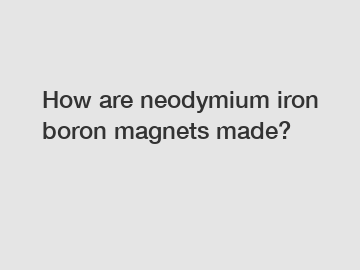How are neodymium iron boron magnets made?
Welcome, curious minds, to a fascinating journey where science, technology, and innovation unite to create wonders that power our modern world! In this blog, we will dive into the realm of neodymium iron boron (NdFeB) magnets, exploring how these remarkable magnets are made. Join us as we unravel the secrets behind their exceptional properties, revealing the craftsmanship involved in their creation.
The Science Behind NdFeB Magnets:
NdFeB magnets are the most powerful permanent magnets known to humans, offering outstanding magnetic strength, high coercivity, and excellent resistance to demagnetization. These magnets owe their remarkable properties to the unique combination of neodymium, iron, and boron elements.

Step 1: Raw Materials Selection:
The process of crafting NdFeB magnets begins with the selection of high-purity raw materials. Neodymium, iron, and boron (along with other trace elements) are carefully blended in precise proportions to obtain the desired magnetic characteristics. The purity of these elements directly impacts the final quality of the magnets.
In addition to the main elements, additives like dysprosium and terbium are sometimes incorporated to enhance the magnets' resistance to temperature changes by stabilizing the magnetic field, addressing the risk of demagnetization.
Step 2: Melting and Alloy Formation:
Once the raw materials are ready, they are smelted in a vacuum induction furnace, equipped to carry out the process under controlled conditions. The carefully measured quantities of elements are mixed and then melted at temperatures reaching up to 1,600°C (2,912°F).
This intense heat allows for the alloys to form, ensuring a homogeneous mixture. The resulting molten alloy is then rapidly cooled to room temperature, creating a fine powder of NdFeB.
Step 3: Powder Pressing:
The NdFeB powder obtained in the previous step is sieved to achieve a uniform particle size distribution. The fine powder is subsequently mixed with a polymer binder to facilitate handling and molding.
Using a magnetic field, the powder is then compacted into the desired shape, be it blocks, discs, or cylinders. During this pressing process, great emphasis is placed on achieving the precise geometry required to harness the magnets' maximum performance.
Step 4: Sintering:
Sintering is where the magic truly happens. The compacted magnets, still fragile and porous, undergo a heat treatment that takes place within a precisely controlled environment. This innovative process is critical in achieving magnetic alignment and strengthening the magnets considerably.
The magnets are exposed to temperatures close to 1,000°C (1,832°F), causing the magnetic particles to diffuse and rearrange. This diffusion process eliminates air gaps and aligns the particles along the desired magnetic axis, thereby enhancing the magnetic properties.
Step 5: Machining and Coating:
After sintering, the magnets undergo a precise machining process that involves grinding, cutting, and drilling, refining them to their final shape and size. This step requires highly skilled technicians and cutting-edge machinery to ensure superior accuracy and consistency.
To protect the magnets from corrosion and oxidation, a protective coating is applied. Nickel, epoxy, or other specialized coatings are commonly used, ensuring longevity and safeguarding the magnets during their service life.
Conclusion:
And there you have it—a glimpse into the impressive journey of how neodymium iron boron magnets come to life. From meticulously selecting the raw materials to the delicate processes of melting, pressing, sintering, and machining, each step demands precision, expertise, and innovation.
These powerful magnets play an indispensable role in countless applications, ranging from renewable energy generation and electric vehicles to medical devices and consumer electronics. They truly are the unsung heroes behind some of society's greatest achievements.
We hope this exploration of the creation of NdFeB magnets has ignited your curiosity and appreciation for the remarkable science and engineering that make our modern world possible. So, next time you come across a seemingly ordinary magnet, remember the marvels hidden within its tiny core!
For more External Threaded Rubber Coated Pot Magnet, Magnet Chamfer China Supplier, Magnetic steel chamfer stripsinformation, please contact us. We will provide professional answers.
146
0
0


Comments
All Comments (0)